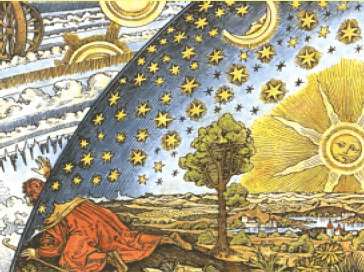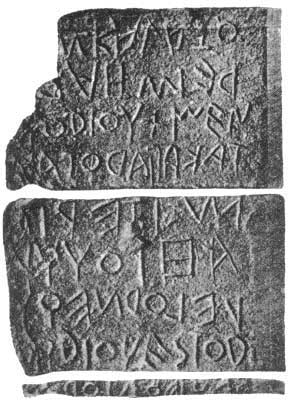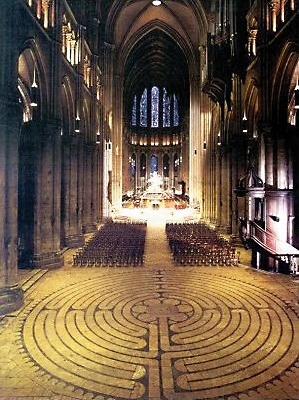Is A New Dark Age At Hand?
The Internet has brought a sudden and tremendous change in the history of man's search for information. We like to think that the Internet, the I-Pod, the I-phone, and all the other "Eyes of the Future" will bring about a new Age of Enlightenment, with all the wisdom and artistry of mankind instantly available to everyone's fingertips.
"...information is like water. It's vital to our lives; we cannot survive without it. But if too much pours over us - we drown."
I dare to suggest that we are drowning, that the dam has burst and we are bring swept by the deluge into a new Dark Age of ignorance and superstition.
The Google glut
In the Dark Ages - which began with barbarians driving Roman civilization from Europe and ended with the Medieval awakening, the Italian Renaissance and the Gutenberg revolution - long nights were filled with gossip, rumor, storytelling, and idle fancies flowing into a fact-impoverished world....
Today, easy access to the Internet is flooding us with gossip, rumor, celebrity tales, and slant that drown out the trickle of actual truth. The Internet can tell you anything you want to know with a googly glance at its googol of inputs. We no longer need seek out and read a book to learn; we need only power a search engine with a few words, even when they're spelt inkorekly.
Internet's Wikipedia, which is as objective as a list on a barroom menu, and often as fully fact-checked as a diatribe, has all but replaced studiously researched encyclopedias.
"Information" is not the same thing as "fact". But eventually, we forget the distinction and uncritically accept all information as truth. When a briefly popular author invented a mythical society, the Priory of Sion, Google was rapidly filled with thousands of references to its history, organization, famous leaders, and its lost, hidden or church-burned documents - none of which were true. Need one add that 70% of us believe in UFOs and 70% believe that JFK was the victim of a political assassination plot.
And thus, if it's "hot" on the Internet, we uncritically accept the fad of the moment. A growing multitude drink water from bottles that Pepsi and Coke fill from New York water faucets rather than drink the water coming out of those faucets because we've been warned that non-toilet trained Catskill fish swam in it.
The stifling of skills
In the Dark Ages, the upheavals from wars and barbarian invasions eroded education and the common knowledge of skills and arts, which were preserved only in a few places such as monasteries....
We accept this flood uncritically because we are no longer trained to use our minds. In ancient days, one was expected to listen to and retain a million words for instant recitation. Then, the Greeks and Romans, and their latter-day Renaissance counterparts, couched their minions to read the written word, rather than listen to some minstrel song, like those from the likes of Homer. But at least education in readin', ritin' and 'rithmetic were still considered a necessity as ways of training the mind to think.
Now, when hand calculators instantly answer the most complicated A/S/M/D mélange conceivable and times-tables are no longer necessary, memory can be used for better things like celebrity gossip and e-mail addresses. Why bother anyway? Sex ed and 'personal development" are the real needs!
The passivation of leisure
We are also losing our leisure skills. Western society brags of the prosperity brought to it by technological breakthroughs while disregarding their social side-effects. These inventions with unintended consequences began with Scotland inventing the Industrial Revolution, thereby causing labor to move from farms to mines and mills. Then the phonograph brought music into every house-bound ear, thereby inducing parents and children, who once learned and played instruments at home and amuse themselves in neighborly song fests, amateur combos, quartets and pickup bands to just sit and listen to the parlor Victrola. Listening replaced performing.
Radio brought entertainment and the world into the living room, so that neighbors and relatives who had once gathered to chat and tell stories sat quietly in front of talking boxes. And why bother to read so much, if just listening is easier and cheaper. In passing, it ought be stated that free radio brought along radio ads that provoked family purchases of a superabundance of Wheaties, Ovaltine, Pepsi, Ivory-soap, Tide and Lux.
Then came television, showing scenes and details that could only be imagined while listening to the radio, so imagination was left to Castles-in-Spain daydream-time. There were also movies, but why drive to theaters when you can watch a move on TV or download it from the Internet.
And what little reading we now do is confined to TV schedules, movie timetables, and magazines and books about the doings of politicians and celebrities whom TeeVee made infamous. Or we try to dig up the real dirt about those celebrities on - yes - the Internet.
We used to go to concerts. Now, enabled by Dialup to download any music onto a CD, music is more easily heard using good earphones than by motoring through downtown traffic to Symphony Hall to look three tiers down at a hundred seated people chugging away! Symphonies are declining everywhere while motion-dominant Opera thrives: another victory for look over listen.
We used to participate in sports. Then, TV began gobbling up the remaining free time, once devoted to stickball, stoopball, roller-skating and burying treasure in empty lots, to watching professional sports on TV or simulating them in computer games. Even the most basic physical activities of our ancestors, such as walking or horseback riding, were obliterated by the automobile - which at least provided some arm and right-foot exercise.. But even that will soon be eliminated by telecommuting and Internet shopping. We are becoming a nation of couch- and console-potatoes.
The triumph of triviality
The upheavals of the Dark Ages so restricted travel that most people lived in isolated villages, unknowing and unconcerned with great issues and preoccupied with the trivia of daily life...
E-mail instantly and cheaply sends our just-thought-ofs' to your computer list. No longer need you spend time writing down and thinking about what you're going to say. And you don't have to worry about spelling [nor own a dictionary anymore]: an email maven corrects spelling [never information or syntax] errors. Messages need not be composed with pith, wit, personality or any particular intent. They need only be laboriously typed without a syntactical glance and sent out quickstep. On hearing "You've got mail", most such free-from-thinking machinations are scanned with deserved dispatch and deleted. Inadvertently have we also deleted from our lives the joys and treasures of personal correspondence - treasured emails lie in the category of seashore sand-castles; they get tidied up in the next tide. Autographed signatures at the bottom of cherished letters have been replaced with scrawls of accidental heroes on baseballs and movie albums.
Cell phones provide instantaneous communiqués to wherever a whomever happens to be. One often talks the instant a name pops into her head so that chatting takes the place of time-wasting speculation about work, family, church or country.
In being preoccupied with trivia, we're only imitating our masters in the entertainment world. With the triumph of FX and morphing, movies and TV shows have lost what little literacy they ever had. Dialogue movies have started to disappear with flash, slash, and bash becoming Hollywood's latest sacred cash-cow. On TV, CSI's multiple second-long quick cuts, and "unscripted" Que Sera, Sera reality shows are replacing slow-moving situation comedies, mysteries, musicals and adventure tales. Modern talkies - and now TV - contain fewer words than silent films showed in their title cards.
And needless to say, the Internet encourages, and amplifies this trend toward triviality: digits ranging through digitized agendas instead of eyes scanning a better known analog world; ear-splitting sounds rather than script-advancing dialogue; dramatic eye-confounding screen switches instead of stage play continuity. Game buttons, Cable remotes, and Internet clicking have trained us to hop, skip, and jump - rather than slowly turn pages in an easy chair.
Envoi
And so, the Internet has induced society to scorch its path from see-read-listen-remember-digest into scan and flip, thereby replacing judgment with opinion, objective reasoning with subjective impression, and common sense with consensus. We are thus becoming perfect little lemmings, easily stampeded by marketers, fad creators, propagandists, and politicians with hidden agendas.
Is our culture navigating the circle back to where darkness lies waiting for us? Is our modern path freeing us from thought - while letting in a new horde of barbarians, the Superficials, to open our gates to a New Dark Age?
With easy-access now on cell phone and soon, perhaps, via a chip implanted into our cortexes or spines, this next fifty years is going to get very interesting (in the
Chinese sense) unless the world ends first - or until something or Someone more meaningful comes.




















